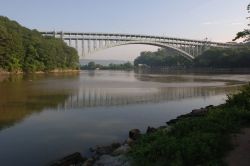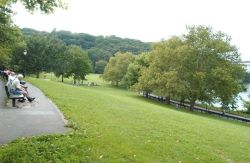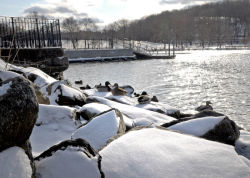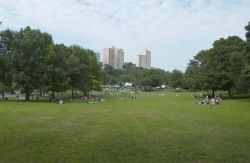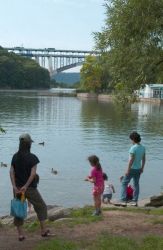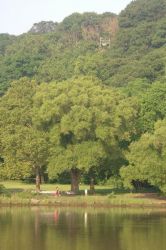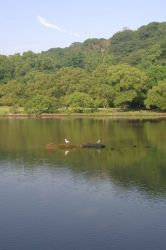Inwood Hill Park
Inwood Hill Park - Fordham Gneiss in New York City
Fordham gneiss, one of the oldest rock formations in the world, can be seen from Inwood Hill Park by looking across Spuyten Duyvil Creek. Named for the Bronx neighborhood where it is most visible, Fordham gneiss was formed around 1.1 billion years ago, in the pre-Cambrian era, during a period of continental shifting. At that time, the continent of North America lay in a narrow basin beneath an ancient, shallow sea. Sand and silt had accumulated in the basin, forming sedimentary rock. During a continental shift, an unidentified landmass collided with North America, thrusting the sedimentary rock upward and forming a mountain range. This collision is known as the Grenville Orogeny, and it occurred at a time when life on earth consisted of algae and bacteria, and multi-celled organisms were beginning to evolve.
The impact of the collision and the high pressures involved caused the sedimentary rock to recrystallize, forming the black-and-white banded, metamorphic rock we see today. The contorted banding pattern of these bands is a testament to the immense geologic force of the shifting plates that formed the gneiss. Over the next hundred million years, passing glaciers and erosion by wind and water wore away the mountain ranges. Further shifting of the landmasses produced Manhattan schist, which can be observed at Inwood Hill Park’s Indian Houses; Inwood marble, named for this area where it can frequently be observed at the surface; and other bedrocks, which all came to rest on or beside the existing layer of gneiss.
In the Bronx, gneiss can be observed running along the surface of the earth in two ridges; one along the west side in Riverdale, and the other along the east side in Fordham, Tremont, University Heights and north into Van Cortlandt Park. Gneiss is also found on Roosevelt Island, emerging from the East River, and in Long Island City, Queens. The rocky cliff that has been painted with the letter “C” and is visible from Inwood Hill Park is one of the few areas in the city where this old bedrock is exposed at the surface.
Check out your park's Vital Signs
Clean & Safe
Green & Resilient
Empowered & Engaged Users
Share your feedback or learn more about how this park is part of a
Vital Park System

Know Before You Go


